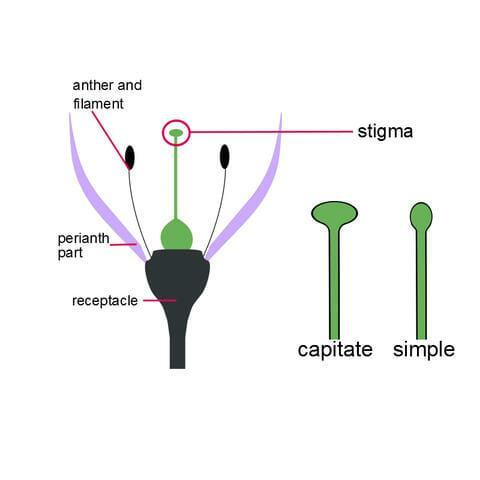
Each pollen grain produces ______ male gametes.
A. Three
B. Two
C. Four
D. One
Answer
498.9k+ views
Hint: Pollen is a fine substance consisting of pollen grains which are male microgametophytes of seed plants, which produce male gametes. In angiosperms, the diploid dust mother cell experiences meiosis-I followed by meiosis II to shape a quadruplicate having 4 haploid microspores.
Complete answer:
The correct answer is B.
This quadruplicate isolates to shape structures 4 haploid dust grains. Every dust experiences mitosis to offer ascent to develop dust with 2 male gametes.
The pollen grains are named microgametophytes, and comprise of a sporopollenin covering which serves to secure the gametophytes’ as they are moved from the stamens (male) or male cone to the pistil (female) or female cone in blooming and coniferous plants, individually.

At the point when the dust arrives at the pistil or female cone, a dust tube is shaped, which ships the sperm to the ovule containing the female gametophyte.
The term fertilization alludes to the exchange of dust grains from the anther to the disgrace of a bloom. Cross-fertilization includes the exchange of dust from one blossom to the disgrace of another bloom. Conversely, self-fertilization includes the exchange of dust from one blossom to the disgrace of a similar bloom. In coniferous plants, dust is shaped in the microsporangia of the male cone, while it is created in the anthers of blossoming plants (likewise named angiosperms). Each microsporocyte is diploid and structures four haploid cells, named microspores, by means of meiosis. This procedure is named microsporogenesis.
The four microspores at that point structure the twofold mass of the dust grain inside a structure made of callose. During this procedure, the callose is processed by callase and the dust grains can develop and finish the arrangement of the endospore and exospore.
Note: Aside from on account of some lowered amphibian plants, the developed pollen grain has a twofold divider. The vegetative and generative cells are encircled by a slim fragile mass of unaltered cellulose called the endospore or intine, and an extreme safe external cuticularized divider made to a great extent out of sporopollenin called the exospore or exine.
Complete answer:
The correct answer is B.
This quadruplicate isolates to shape structures 4 haploid dust grains. Every dust experiences mitosis to offer ascent to develop dust with 2 male gametes.
The pollen grains are named microgametophytes, and comprise of a sporopollenin covering which serves to secure the gametophytes’ as they are moved from the stamens (male) or male cone to the pistil (female) or female cone in blooming and coniferous plants, individually.

At the point when the dust arrives at the pistil or female cone, a dust tube is shaped, which ships the sperm to the ovule containing the female gametophyte.
The term fertilization alludes to the exchange of dust grains from the anther to the disgrace of a bloom. Cross-fertilization includes the exchange of dust from one blossom to the disgrace of another bloom. Conversely, self-fertilization includes the exchange of dust from one blossom to the disgrace of a similar bloom. In coniferous plants, dust is shaped in the microsporangia of the male cone, while it is created in the anthers of blossoming plants (likewise named angiosperms). Each microsporocyte is diploid and structures four haploid cells, named microspores, by means of meiosis. This procedure is named microsporogenesis.
The four microspores at that point structure the twofold mass of the dust grain inside a structure made of callose. During this procedure, the callose is processed by callase and the dust grains can develop and finish the arrangement of the endospore and exospore.
Note: Aside from on account of some lowered amphibian plants, the developed pollen grain has a twofold divider. The vegetative and generative cells are encircled by a slim fragile mass of unaltered cellulose called the endospore or intine, and an extreme safe external cuticularized divider made to a great extent out of sporopollenin called the exospore or exine.
Recently Updated Pages
The correct geometry and hybridization for XeF4 are class 11 chemistry CBSE

Water softening by Clarks process uses ACalcium bicarbonate class 11 chemistry CBSE

With reference to graphite and diamond which of the class 11 chemistry CBSE

A certain household has consumed 250 units of energy class 11 physics CBSE

The lightest metal known is A beryllium B lithium C class 11 chemistry CBSE

What is the formula mass of the iodine molecule class 11 chemistry CBSE

Trending doubts
State the laws of reflection of light

One Metric ton is equal to kg A 10000 B 1000 C 100 class 11 physics CBSE

Difference Between Prokaryotic Cells and Eukaryotic Cells

How do I convert ms to kmh Give an example class 11 physics CBSE

Describe the effects of the Second World War class 11 social science CBSE

Which of the following methods is suitable for preventing class 11 chemistry CBSE




